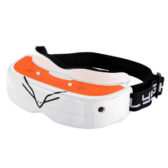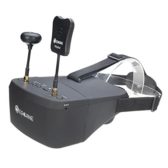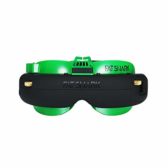The Best FPV Goggles for Flying a Drone in First-Person View
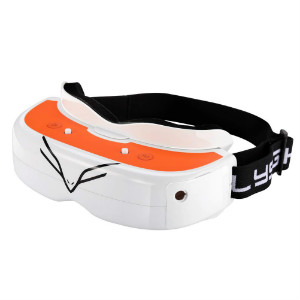
Flysight Falcon FG02
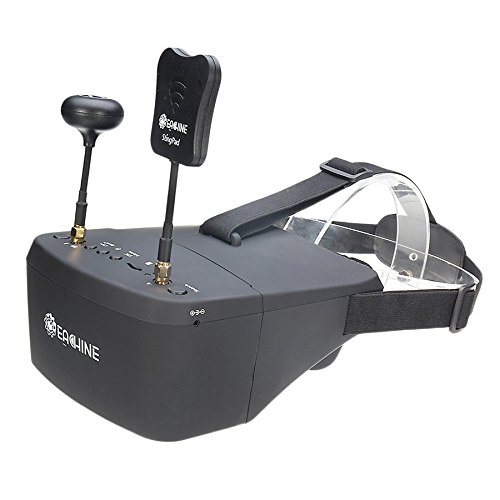
Eachine EV800D
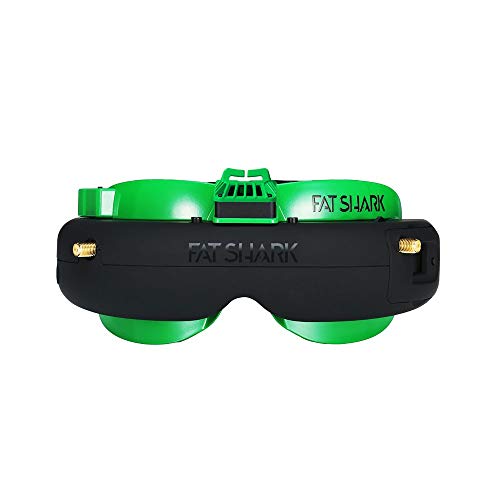
Fat Shark Attitude V5
FPV flying is meant to be an immersive and natural way to fly a drone. However, just using your controller or smartphone’s screen to view the live footage is shortchanging that experience by more than just a little bit.
For maximum impact, there’s nothing like using FPV goggles.
FPV goggles remove you from your current physical reality and transports you inside the drone. Not only that, but it makes flying the drone much easier!
But not any FPV goggle will do. There are certain factors you need to consider when buying one to get the best FPV experience possible, so we’ll look into that. Plus, we’re going to give recommendations on the best FPV goggles you can buy.
First, a very quick overview.
What are FPV Goggles?
FPV goggles, or a VR headset, is a way to see your drone’s live feed during FPV mode using a set of wearable glasses. The screen is shown directly to your eye and everything else is blocked out from your vision.
The result is an entirely immersive flying experience, giving you the impression that you’re inside the drone itself.
To use them, you need a drone that can fly in FPV (First Person View) mode. We’ve already rounded up the best FPV drones that are out there. This type of drone makes use of its onboard camera to capture real-time video footage of what it “sees.”
This is then streamed to a monitor or, in our case, a VR headset. The headset is equipped with a receiver module, which grabs the video signal and displays it to the goggle’s internal screen.
It’s similar to how VR works. The difference, of course, is that VR is a simulated reality, while FPV gives you a more immersive view of the real world.
The most prevalent use of FPV goggles is in drone racing, to the point that it’s practically a requirement there. This is because flying in this mode gives you much better reaction times at high speeds. It’s the only way to have the precision necessary to fly through an obstacle course successfully.
Aside from racing, they just make flying a drone that extra bit more enjoyable.
The Best FPV Goggles
We may receive compensation on qualifying purchases via our links. This does not change how we review items. For more information, please read our affiliate disclosure.
No products found.
The Flysight Falcon FG02 is a compact and slimline FPV goggle that is priced competitively.

- Type: Slimline
- Frequency Range: N/A (no receiver included)
- Resolution: 854 x 480 (WVGA)
- Aspect Ratio: 16:9 and 4:3
- IPD: 59 – 69 mm
- FOV: 33 degrees
- DVR Function: Yes
The FG02 is equipped with two 0.32-inch LCD screens, each with a resolution of 854 x 480. The full color display is brilliant and gorgeous, with an LED backlight. Shortcut keys are conveniently located as well, should you need to adjust brightness and contrast on your display.
The FG02 is all about flexibility and can adapt to almost any drone model. The aspect ratio is switchable from 4:3 to 16:9, and it can handle both analog and digital connections
One other selling point of the FG02 is the custom receiver bay. With it, you can outfit it with any receiver module, such as Fat Shark Nextwave. By doing so, you can fine-tune your signal based on the receiver that you use.
However, this means that for beginners, it necessitates buying a separate receiver module since the FG02 doesn’t come packed with any. It might be inconvenient for the newbie user, but for the pro, it’s a small price to pay for the flexibility that you’ll get.
If you want to use digital-based connections like the DJI drones, you can do it as well via the HDMI cable ports. There’s also an AV In port.
The FG02 also has a DVR built-in, which does an excellent job of recording in-flight footage. In addition, it has the ability to auto-save your recordings should you lose power.
Overall, the Flysight Falcon FG02 is a powerful and flexible FPV goggle that can fit in almost any situation. With high-quality screens, comprehensive support, and customizable bays, this a goggle that’s great for both casual and serious users.
+ Pros
- Cons
No products found.
No products found.
The Eachine EV800D is one of the best value for money FPV goggles you’ll find in the market, getting brownie points for ease of use and diversity function.

- Type: Box Goggles with a 5-inch screen
- Frequency Range: 5.8 GHz with 40 channels
- Resolution: 800 x 480
- Aspect Ratio: 4:3 and 16:9
- Battery Life: 2 hours
- DVR Function: Yes
For one, the EV800D comes with a 5-inch LCD screen that has a resolution of 800 x 480, which gives pretty clear footage. This is detachable, so you can use it as an FPV monitor if you want to.
The clarity and brightness are commendable, and the 82-degree FOV is just right; it felt immersive yet didn’t have to move my eyes around. The edges of the screen also don’t blur or distort.
The goggles themselves are surprisingly comfortable, and the padding on the contours snugly fits my face. The straps were honestly hard to put on, but we got used to it after a few tries. The weight of the goggles is on the lighter side, so definitely no strain there.
The EV800D is compatible with the majority of FPV drones so long as they can use the 5.8 GHz frequency. Switching channels is also easy, and you can auto search to find the best on. Scanning for the right channel was iffy at times, and you have to play around with it. But once you find it, it manages to lock on without any problem.
The DVR function also works well and is easily accessible thanks to the buttons laid out pretty well on the top of the goggles. The recording is smooth, and there is no noticeable lag at all compared to the DVR output of some cheaper models. Output resolution is 720 x 576, which might not be high res but is good enough for reviewing racing footage.
Finally, for those that wear glasses, you won’t be able to wear them while having the EV800D on, but you CAN slide them on to the goggle’s frame, so you can still use them.
Overall, the Eachine EV800D is an excellent FPV goggle for the beginner. It’s easy to use and fits well, plus the DVR function is an added bonus for those who are getting into racing. The less than $150 price tag isn’t too shabby as well.
+ Pros
- Cons
No products found.
No products found.
This headset features the same specs as its more powerful older brothers (like the HDO) but is priced much lower.

- Type: Slimline
- Frequency Range: 5.8 GHz
- Resolution: 640 x 400 OLED
- Aspect Ratio: 4:3
- IPD: 59 – 69 mm
- FOV: 30 degrees
- DVR Function: Yes
The Attitude V5 hails from Fat Shark, a well-known player in the FPV goggle industry.
The Attitude V5 features two 640 x 400 OLED screens, with a standard 30-degree FOV. Even at a relatively low resolution, the image output from the OLED is bright and sharp enough for you to make out small details like power lines.
The incredible clarity and brightness of the screen are some of the most significant selling points of this FPV goggle. You can also tweak the screen’s brightness and contrast to suit your preference.
The build of the Attitude V5 is top-notch. The outer shell is durable and doesn’t look cheap. The thick padding is very comfortable to the face and allows for a snug fit. However, there is a noticeable light leak near the nose, where the foam is not as thick.
The IPD adjustment isn’t as robust and will take some getting used to. The problem is the range of adjustments wasn’t small enough to achieve satisfactory results, and if I had a problem, then I’m sure someone else might have the same issues.
Performance-wise, the range and frequency of the included receiver module are impressive enough. You can race the drone fast enough, and the FPV goggle would still be able to achieve smooth, lag-free video streaming. If this isn’t enough, then you can easily swap this out for a better one thanks to its interchangeable module bay.
Despite some minor flaws, the Fat Shark Attitude V5 is still a fantastic mid-ranged FPV goggle with above-average specs. Bright and crisp OLED screens, module bay, and a comfortable fit make this a headset we see ourselves using for a long time. If you’re a racer, this is a good choice!
+ Pros
- Cons
No products found.
DJI’s FPV Drone Goggles are powerful and comfortable FPV goggles that are meant to be used with their line of drones.
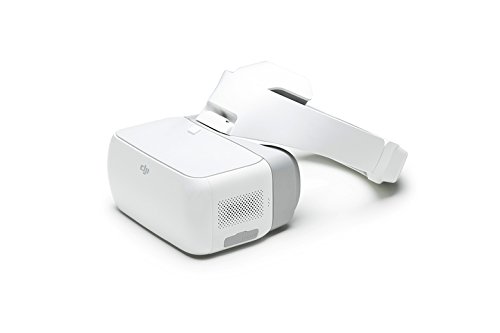
- Type: Slimline
- Frequency Range: 2.4 GHz
- Resolution: 3840 x 1080 (1920 x 1080 per screen)
- Aspect Ratio: 16:9
- FOV: 85 degrees
- DVR Function: Yes
- Battery Life: 6 hours
In true DJI fashion, the specs are above the average of what you’d expect for a typical pair of FPV goggles. For one, the resolution on these things is a ridiculous 3840 x 1080, or 1920 x 1080 per screen. It has an FOV of 85 degrees, giving plenty of coverage to complete the illusion.
This gives some of the most cinematic, highly detailed footage ever possible from an FPV goggle. While it might look good on paper, most FPV drones are nowhere near that level of FPV resolution.
These DJI goggles are long range, capable of matching the equally long transmission distances of most DJI drones.
It does this by utilizing DJI’s OcuSync wireless transmission system, which is present in most DJI drones like the Mavic 2. It also offers 360 coverage, ensuring that you can stay connected with the drone even if it’s behind you. With low latencies of 120ms, it results in super-smooth FPV with zero lag.
Because of their tight integration with each other, DJI Goggles are more than just for one-way viewing. You’ll actually be able to directly control many of the drone’s features and flight modes from the VR headset itself. In a way, it’s like an FPV goggle and remote controller all in one.
The most basic of these is controlling the capture of photos and videos. You can also utilize the many intelligent flight modes present in a lot of DJI drones like ActiveTrack and Tripod Mode. Plus, the goggle is equipped with Head Tracking, allowing camera movements by moving your head.
With over 6 hours of operating time and a comfortable ergonomic design, DJI’s Goggles are as feature-packed as their drones. It offers such a tight integration with DJI drones that it goes beyond just VR viewing.
+ Pros
- Cons
The Viper 2.0 FPV Goggles is a stylish modular box goggle, great for wearers of glasses and non-wearers alike.
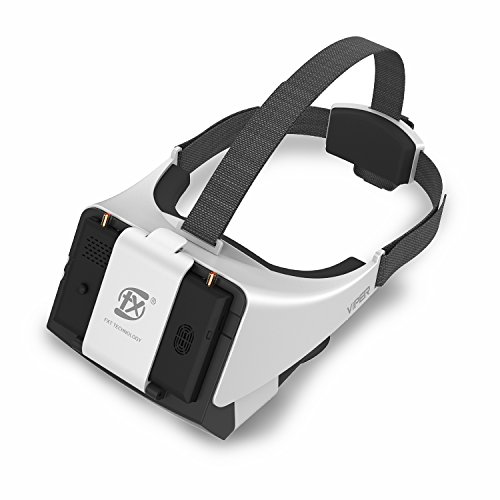
- Type: Box Goggles with a detachable 5-inch screen
- Frequency Range: 5.8 GHz with 40 channels
- Resolution: 800 x 480
- Aspect Ratio: 4:3 and 16:9
- DVR Function: Yes
The modular nature of the Viper 2.0 allows you to separate the goggle frame, detachable screen, and sunshade from each other. How you recombine them back depends on your situation.
For its “full form” with all components attached, it functions as a fantastic VR headset. The brilliant high resolution (800 x 480) screen gives terrific brightness and color definition to the video output from this unit. Any light leakage is unnoticeable once you turn the screen on.
Removing the sunshade opens up the side of the goggles, giving enough space for you to wear glasses, but still allowing you to do FPV. This also enables you to do FPV and LOS (Line of Sight) flying from your peripheral at the same time.
By the way, the brilliant thing about the Viper 2.0 is the distance from your eyes to the screen. It uses a patented optical refraction technology to minimize eye strain and allows comfortable viewing even for long periods.
Finally, you can remove the screen itself and use it as an FPV monitor.
The goggle frame itself has an ergonomic design, which snugly fits on your face and nose bridge. The whole structure is built really well, and it doesn’t feel cheap at all.
The Viper 2.0 has a built-in DVR recorder that can store up to 10 minutes worth of live footage. Starting/stopping records can be easily accessed via a quick one key button.
Finally, the 5.8 GHz frequency range is compatible with most modern FPV drones. You can also store your favorite channels list, so you can quickly return to them next time.
Overall, the Viper 2.0’s modular frame is what sets it apart. It gives those with eyeglasses the chance to properly use the headset while giving others the option to do FPV and LOS at the same time.
+ Pros
- Cons
If you want incredibly cheap FPV goggles, the Arris VR-009 could be just the ticket.
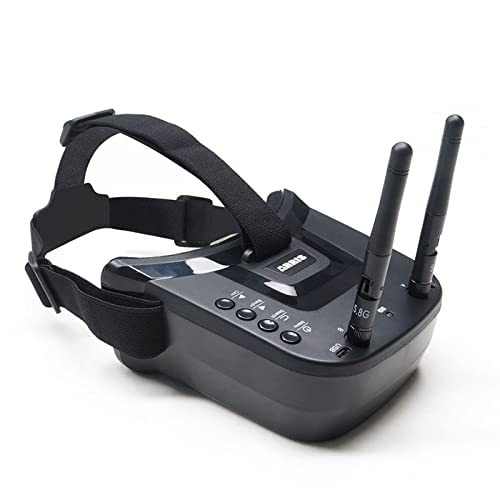
- Type: Box with a 3-inch screen
- Frequency Range: 5.8 GHz with 40 channels
- Resolution: 480 x 320
- Aspect Ratio: 16:9
- FOV: 33 degrees
- DVR Function: No
- Weight: 183g
These ultra-small and lightweight (only 183g) and affordable headsets are great for getting into the world of VR drones with minimal budgets.
At a little less than $50, we were pretty skeptical at first if the VR-009 can deliver. It certainly looks like a generic VR headset. But doubts were put to rest when we put the goggles on for a test spin.
The 480 x 320 resolution is decent. It was able to output bright and vibrant images, with a gorgeous full color definition. The size of the screen was just about right, and we didn’t feel the need to strain our eyes just to look at certain areas of the frame.
The super lightweight nature of the VR-009 makes it a joy to wear. Its weight barely registers on your face, and that somehow added to the immersive effect of the goggles.
The receiver has a good range and works in the standard 5.8 GHz frequency. It can operate in 40 channels, and even has an auto-search feature. The double antenna makes the signal more stable and results in smooth and lag-free video footage.
The battery life is quite commendable at 2.5 hours, thanks to its lower power consumption. Charging is as simple as hooking it via a USB cable.
As for other features, there’s unfortunately not much. This is about as straightforward as you get. It’s an affordable, no-frills FPV goggle that gives you no excuse not to look into the VR drone world.
At a price that’s less than $50, it’s the cheapest way you can get yourself into VR FPV drone flying.
+ Pros
- Cons
Buyer’s Guide: FPV Goggles
Things to Look For
FPV Goggles all accomplish the same purpose, but that doesn’t mean they are all created equally. Since they contribute so much to how immersive your experience is, picking the right one is vital.
Here are some things you need to consider:
Form Factor
Form factor refers to the overall size, shape, and physical characteristics of your FPV goggles. This is important because you want them to be portable, yet comfortable and functional at the same time.
Most of the goggles you see in the market will either be box type or slimline (low profile). The main difference between the two is the size, but there are subtle variances.
Box goggles have a single 3 to 6 inch LCD screen that’s attached to a headset. Some low-cost models don’t even have a screen, using your smartphone instead to act as one.
These are much easier to manufacture, and are therefore much cheaper. They also tend to be larger and bulkier, which makes transporting them much more difficult. However, the bigger form factor hugs your face better, which makes box goggles much more comfortable to wear over long periods.
Slimline goggles, the other type, uses two smaller LCD screens instead of one. They are designed to be aligned with each eye, much like how glasses or binoculars work. The smaller glasses can be placed closer to the eye, allowing for much smaller and slimmer designs.
Because of this, slimline glasses are much more portable and compact, enabling you to carry them around much easier. They’re lighter, too, so it’s not as straining to your head and neck. However, a lot of people prefer the comfort a larger box goggle gives.
Performance-wise, though, you can’t go wrong with either type so long as they’re made with quality components. The form factor is mostly based on budget and preference.
Receiver Frequency
For you to view the live footage, the signal must be received from your drone’s transmitter. This is usually transmitted in specific frequencies, and you have to make sure your goggle’s receiver frequency is compatible with that of your drone.
Different ranges have different properties. Lower frequencies, for example, can travel for long distances and can quickly go through solid objects such as walls. Higher frequencies have a shorter range but allow for more significant bandwidth and, therefore, much better quality footage.
In a nutshell, the frequencies a drone can operate in ranges from 900 MHz to 5.8 GHz. The two most common ones, though, are 2.4 GHz and 5.8 GHz.
The 2.4 GHz frequency is the most common for sending command signals to your drone since it has a long range. It can also be used for streaming video feeds, but the quality tends to be lower. It’s also relatively inexpensive to produce 2.4 GHz transmitters.
A problem with 2.4 GHz is that a lot of other wireless devices operate in this range, including WiFi. Hence, you’ll most likely encounter a lot more interference when you’re running your VR headset and drone in this channel.
The 5.8 GHz frequency is popular for streaming data-intensive transmissions, such as live video footage. Thanks to its more significant bandwidth, the video quality is much better. Using the 5.8 GHz frequency for FPV also helps avoid interference with the drone control signals, which can be done at 2.4 GHz.
5.8 GHz is also not that expensive to produce and is legal in all countries. Hence, why more drones and VR headsets support this frequency.
For the utmost in flexibility, some FPV headsets don’t have a receiver built-in. While this might be inconvenient for most, for some pro users, it means they have the freedom to choose the receiver they want to use, and swap if necessary.
Resolution
Like any consumer device with a screen, FPV goggles also have a resolution. This is the total number of pixels your screen can display, which tells you how clear of a video quality it’s capable of displaying.
There are lots of screen resolutions available, but the most common ones are QVGA (320 x 240) and 1280 x 720. Other resolutions include SVGA (800 x 600) and VGA (640 x 480).
Generally speaking, the higher the resolution, the more pixels involved, and the sharper the footage. Of course, this has a lot to do with the overall quality of your camera. Even the highest resolution VR screen will show crappy footage if your drone’s FPV camera is not up to par.
In short, it’s no use getting a hypothetical 4K resolution goggle if your drone can only do 720p FPV. And 4K FPV really could be considered overkill.
Aspect Ratio
The resolution only describes one part of your screen. Another one is aspect ratio, which tells you the ratio of your VR screen’s height vs. its width. It’s an important metric because it essentially dictates the shape of your screen.
FPV goggles have an aspect ratio of either 4:3 or 16:9. Choosing one is mostly based on preference, but you do have to match the aspect ratio of both your drone and your goggles.
4:3 gives you a much more square-shaped screen, which gives the illusion of a narrower FOV. The majority of drone cameras capture in 4:3, so a lot of FPV glasses will have this as the default aspect ratio.
16:9 offers a much wider screen shape and gives a much more cinematic feel. This aspect ratio is not that common yet but is quickly gaining adoption in the drone space.
It’s possible to have differing aspect ratios between the goggles and the drone, but you’ll end up with a distorted image.
For example, if a drone transmits a 4:3 live feed to 16:9 VR goggles, then the image will look stretched. If the reverse happens (4:3 goggles with a 16:9 drone), then the live feed will become squished.
Some FPV goggles, however, can adapt to this by having the ability to switch between these two aspect ratios. Instead of distorting the footage, the goggles crop them instead to maintain the look of the footage.
Field of View (FOV)
FOV is described in degrees since it’s measured by the angle between the eyes and the corners of the screen. The wider the FOV angle, the bigger the screen appears to be since its closer to the eye. This makes the image more immersive since it tends to “cover” your entire viewpoint.
There’s a limit, however. If the screen becomes too large or too close, then the eye has to scan around to see parts of the footage. This can be straining and, more importantly, breaks the illusion.
The FOV for box goggles and slimline goggles are totally different, so they shouldn’t be used to compare with one another (remember that the former only has one screen, while the latter has two). Box goggles have typical FOVs of 50 – 80 degrees, while slimlines have 25 – 50. Anything beyond these ranges will make VR mode hard for anyone.
Interpupillary Distance (IPD)
Interpupillary Distance (IPD) is the distance between the two pupils of your eyes. This is a relevant spec for slimline FPV goggles and binoculars. In essence, if your IPD doesn’t match with that of your goggles, the image you’ll see will be blurry and out of focus.
Every person has a unique IPD, which makes buying FPV goggles with a fixed IPD generally a bad idea.
FPV goggles with adjustable IPD is the way to go. This allows you to fine-tune the clarity of the image you see. In addition, you can let anyone else use it.
Headtracking
Headtracking is a cool technology that some FPV goggles have. This allows your headset to capture your head movement, which it uses to move the drone’s camera but the same amount.
In practice, this means you can change your viewpoint by merely moving your head. It makes for an even more immersive and realistic experience and can make framing shots or surveying an area that much easier.
However, headtracking is recommended for steady, slower flights. Having it on during racing can make the drone look away with an accidental head movement, which is not advisable for even one second!
HDMI Output
Some goggles are equipped with an HDMI port, which allows you to connect it to various computers and devices. This is most commonly used with a computer running an FPV simulator, enabling you to practice flying in a virtual world.
You can also connect it to your computer or home entertainment system and watch movies from your FPV! Nothing beats the experience of watching movies this way.
No doubt, there’ll be other ways to connect to other devices in the future, and having an HDMI port can extend the functionality of your headset.
Digital Video Recording (DVR)
Several FPV goggles allow you to record the streaming live footage to an inserted SD card. You can do this to record beautiful footage, but of course, don’t expect a high-resolution result. Instead, DVR is used more as a diagnostic and safety tool.
By reviewing your FPV footage, you can analyze your performance after a race and see areas of improvement, for example. Or you can also use it to find evidence or the cause of your drone’s crash, if ever. It’s more or less similar to the dashboard camera usually mounted on cars.
On Screen Display (OSD)
While this is technically not part of a VR headset per se, getting OSD on your FPV viewpoint is crucial for a safer flight.
OSD is a way to display critical information directly on your VR screen. These include vital information like battery level, distance from takeoff point, and signal strength, among others more.
As you can imagine, this is very important for VR flying since you have no way of knowing all of these flight-critical data without taking off your headset. For example, knowing how much battery you have left is essential to know so you can safely land your drone in time.
The hardware needed for OSD can either be placed externally in the drone or as an integrated component in its flight controller.
Can You Wear Glasses with FPV Goggles?
A common concern of people who want to buy FPV goggles is when they’re wearing glasses. Fortunately, there are plenty of workarounds you can choose from.
The easiest would be to go with a box type design since these provide plenty of room for your eyeglasses to fit in. Although not all goggles and glasses are sized universally, so do double-check before buying.
If you prefer to use slimline goggles, then you need to remove your glasses. In this case, you can either get diopter inserts to act as your eyeglass substitutes or just use some good old contact lenses.
The Benefits of FPV
It’s more immersive
FPV goggles give you the most immersive experience ever when you’re flying an FPV drone. You have no other things in view that could distract you, making you feel as if you’re in the scene yourself.
The experience is also pretty unique and is the proper way to fly in FPV mode.
It allows you to race better
Racing with an FPV goggle gives you the opportunity to see what the drone sees that much faster. This gives you quicker reaction time, allowing you a higher chance of avoiding obstacles and therefore being a better racer.
What’s more, it also doesn’t distract you from anything else in your surroundings. When racing via an FPV monitor, you’re much more prone to something interfering and disturbing your focus. With your FPV goggles on, it’s just you, the drone, and the track. You’re focused.
It works in any lighting situation
One of the biggest problems with FPV monitors is glare. This is especially true when you’re flying FPV outdoors on a bright sunny day. The sun can cast a reflection on your FPV monitor, which makes it hard for you to see anything to maneuver your drone.
With VR headsets, this is mostly eliminated. Since it has a snug fit, it doesn’t let any light go inside to “leak” to your image. The result is a bright, crystal clear image, no matter what time of day you use it.
If you’re a drone racer and have to fly fast outdoors under the sun, then an FPV goggle is mandatory.
It makes moving the camera around easier
Some drones are equipped with Headtracking Technology. This enables the FPV goggle to detect any head movement, then move the drone’s camera by the same amount. In short, you can move the drone’s camera just by moving your head around!
This is actually a very natural and convenient way to view your surroundings or frame an area for a photo or video. It can be as easy as looking around for the perfect photo opportunity. Likewise, you can also use head tracking when you’re doing inspection runs with your drone.

